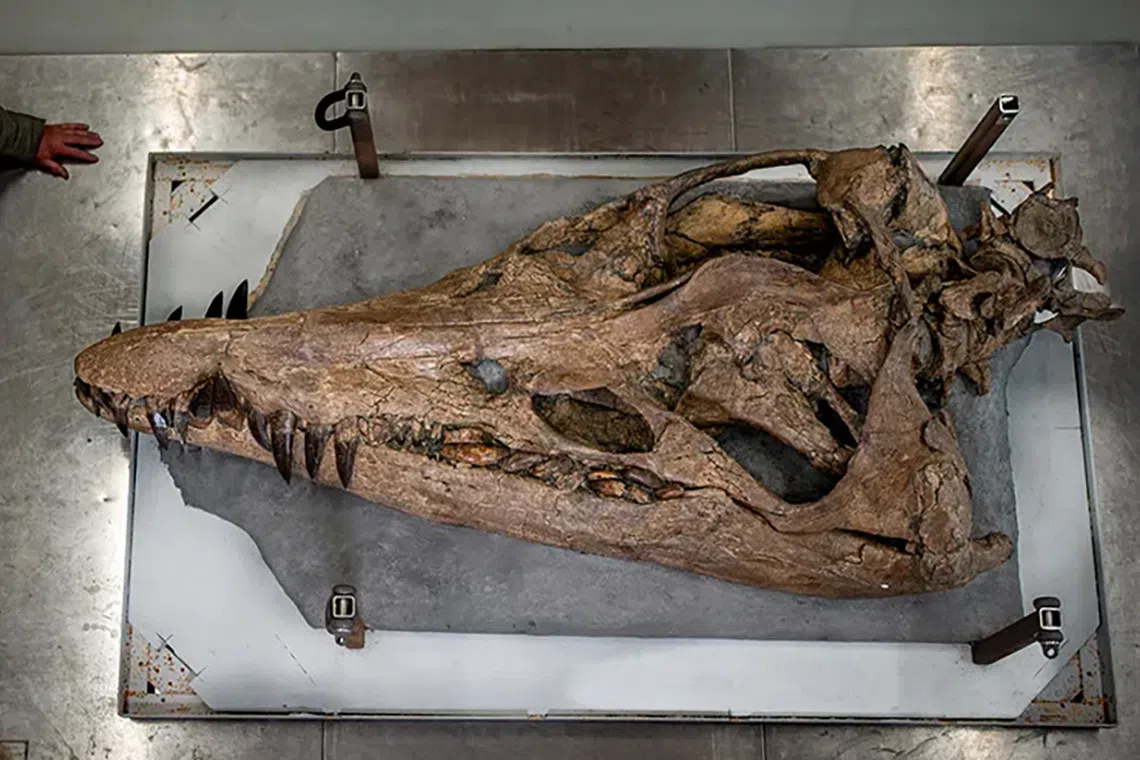Skull of ‘sea monster’ that lived over 100 million years ago found off UK’s Jurassic Coast
Sign up now: Get ST's newsletters delivered to your inbox

The skull consists of 130 sharp and long teeth, with fine ridges on the back of each tooth.
PHOTO: BBC
Follow topic:
The 2m-long skull of a reptile that lived in the sea about 150 million years ago has been discovered at Jurassic Coast, a Unesco world heritage site, in southern England.
A BBC report on Dec 10 said the fossil of a pliosaur is one of the most complete specimens of its type ever discovered, and will be featured in a special programme hosted by natural historian David Attenborough on New Year’s Day.
Pliosaurs refer to a group of marine carnivorous reptiles that are characterised by their strong jaws, big teeth and short necks.
Palaeontologist Steve Etches told the British public service broadcaster that it is one of the best fossils he has worked on, and that the completeness of the discovery is what makes it unique.
A palaeontologist is an expert on fossilised animals and plants.
Said Dr Etches: “The lower jaw and upper skull are meshed together, as they would be in life. Worldwide, there’s hardly any specimens ever found to that level of detail. And if they are, a lot of the bits are missing, whereas this, although it’s slightly distorted, it’s got every bone present.”
The skull consists of 130 sharp and long teeth, and fine ridges mark the back of each tooth.
As the former apex predator in the ocean, the pliosaur measured between 10m and 12m long, and had four flipper-like limbs to thrust itself through the sea.
“The animal would have been so massive that I think it would have been able to prey effectively on anything that was unfortunate enough to be in its space,” said Dr Andre Rowe from Bristol University.
“I have no doubt that this was sort of like an underwater T. rex.”
The pliosaur would have fed on other reptiles such as the plesiosaur and ichthyosaur, and fossil evidence shows that it would have eaten other pliosaurs as well.
The skull was discovered by fossil enthusiast Phil Jacobs during a beach stroll near Kimmeridge Bay at Jurassic Coast.
As he could not carry the fossil on his own, he enlisted the help of Dr Etches. The pair made a makeshift stretcher to lift the fossil to safety.
Having examined the large openings at the rear of the creature’s head, palaeobiologist Emily Rayfield estimated the force generated to crush prey in its mouth to be 33,000 newtons.
In comparison, saltwater crocodiles – which have the most powerful jaws among living animals – use about 16,000 newtons to snap their jaws shut.
The features, such as small pits within its snout to detect water pressure changes made by prey, discovered on the fossil also suggest that it had strong and useful senses, said the report.
The skull will be put on display at Dr Etches’ museum in Kimmeridge, south-west England, from 2024.
The fossil has some vertebrae poking out the back of its head and trails off with a few bones, which might be a sign that more of the fossil might still be left in the cliff of Jurassic Coast.
“I stake my life (that) the rest of the animal is there,” Dr Etches told BBC News.
“And it really should come out because it’s in a very rapidly eroding environment. This part of the cliff line is going back by a foot a year. And it won’t be very long before the rest of the pliosaur drops out and gets lost. It’s a once in a lifetime opportunity.”


